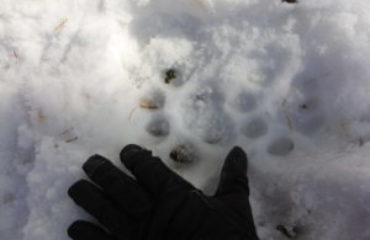By Gabi Morey, Education Outreach Director, San Jun Mountains Association
Sometimes winter in the forest can seem like there isn’t much going on – especially if, like me, you might be out there with a group of 60 excited school children. Wildlife often make themselves scarce when that school bus pulls up. However, even if I don’t see them, I always know that an animal I love to teach and learn more about, the Abert’s squirrel, is around from the evidence they leave behind. Curious? Read on to find out more.

If you’re lucky enough see an Abert’s squirrel, you’ll recognize it most likely from its signature ear tufts, or tassels. These can be longer in the winter, and may almost seem to disappear in the summer. These squirrels typically have a grey back with reddish color on the sides, with a white belly. They weigh about 2 pounds and their head and body are about 12 inches long, and tail is about 9 inches long. They mate in the spring and have a litter of 2 to 5 pups about 40 days later.
Abert’s squirrels are found in Colorado, southeast Utah, and south into New Mexico, Arizona, and even Mexico. There are 9 subspecies of Abert’s squirrels that are associated with different areas, but one commonality among almost all the geographic areas (Mexico excepted) is the presence of ponderosa pine trees. Abert’s squirrels have a mutualistic, symbiotic relationship with these trees, which provide them with just about everything they need in terms of food and shelter. They eat seeds from the pine cones, inner bark, buds, and pollen cones. They will pluck a mature pine cone from a tree, remove the scales, then eat the protein-packed seeds. They also eat pine needles and the ‘inner bark’, or phloem, of twigs from the trees. One of my favorite ‘nature finds’ in the winter are the ends of ponderosa pine twigs on the ground. Abert’s squirrels gnaw off the ends of the branches, letting the pine needle ends fall to the ground. They retain the remainder of the branch, removing the outer bark, and eating the inner bark. The dropped twigs can coincidentally provide food for mule deer. In the summer the squirrels will collect mushrooms, and hang them all over trees to dry. These become winter meals for the squirrels. For shelter, the squirrels build nests out of small branches of the ponderosa pine that they can weave into a safe place to raise young. They also often use mistletoe found in the trees as a great place to build a nest.
Some researchers have found that Abert’s squirrels return to the same ponderosa pine trees year after year. It appears that trees the squirrels prefer have more sugary sap, as well as more carbohydrates, nitrogen and sodium, and less iron, and mercury. Other researchers have found that the preferred trees may simply have bark that is easier to remove.
Interestingly, the squirrels actually help the ponderosa pine trees, in addition to using them. Ponderosa pine trees have a mutualistic relationship with mycorrhizal fungi, found in the soil. The fungi extend the reach of the tree’s roots, helping it get to more water, phosphate, nitrogen and other nutrients, while the tree provides the fungi with carbohydrates. From late spring to early fall, the squirrels eat the ‘fruiting body’ of the ectomycorrhizal fungi – the part that shows up above ground for part of the year. This mushroom has spores throughout it, which the fungi use to reproduce. When eaten, the spores survive through the digestive tract of the squirrel, coming out in its scat, and get spread throughout the ponderosa pine forest, especially those trees where the squirrels like to hang out. This is an amazing trifecta of a mutualistic relationship – among the Abert’s squirrels, ponderosa pine trees, and ectomycorrhizal fungi.
Of course, the squirrels are a continuing part of the food chain. Goshawks, a type of forest raptor, are the main predator of Abert’s squirrels. Other predators may include bobcats, mountain lions, and coyotes.
This winter when you are out exploring our beautiful ponderosa forests, take a quiet moment to look around – chances are you’ll find evidence of some of our tree-dwelling, and tree-helping, friends around.



